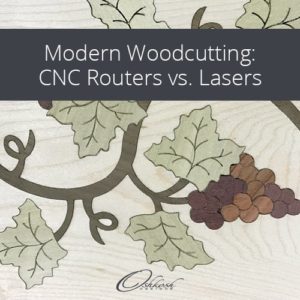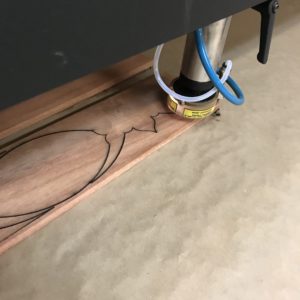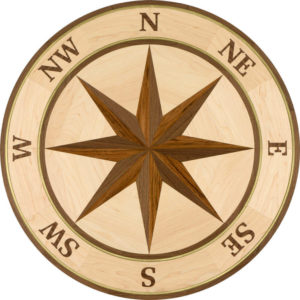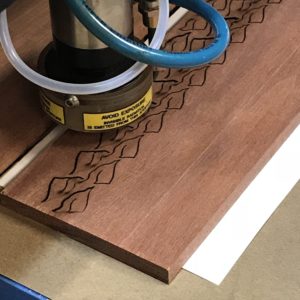
At Oshkosh Designs, we believe that a basic understanding of this process is beneficial. It can tell you what to look for and so help you to make more informed choices.
Automated Cutting Machines
Much of the professional woodcutting done today is accomplished using Computer Numeric Control (CNC) devices. Operations once undertaken by hand are now performed more quickly and efficiently using these new tools. But not only do these new tools make traditional woodcutting operations more efficient, they also open up new possibilities for the art of woodcraft.
CNC Devices

The Woodcutting Process
Cutting with a CNC device is very much like sending a document to a printer. First, a design is created on a computer using drafting software such as AutoCAD or CorelDRAW. When a designer is satisfied with the draft, a section of wood is placed on the cutting surface. The design is then sent from the computer to the CNC device, signaling it to cut. The machine interprets the draft as a series of detailed directions and moves the cutter back and forth and side to side along the axes, cutting the wood as it follows the shape of the design.
One advantage of CNC cutting devices is that, unlike cutting with a saw, it is just as easy for a CNC cutter to make diagonal or curved cuts as it is to cut in a straight line. The type of cutter used will determine the type of cuts possible, as well as the appearance of the final product.
CNC Routers
When woodworkers talk about CNC cutters, they are most often referring to CNC routers. To understand what routers can and can’t do, it is important to note that they cut with friction. A cylindrical bit resembling a drill bit with sharp sides spins at high speeds and carves away unwanted material. Unlike a drill, however, a router can cut both in and out and side to side.
Depth of Cuts
In the past, one of the main advantages to using a router over a laser was the ease with which it could cut to precise depths. A CNC router can be adjusted up and down (along the Z-axis), making the depth of the cut simple to control. In other words, the height of the cutter can be set so that only some of the wood’s surface is cut away.
Controlling the depth of cuts was traditionally difficult to accomplish using laser cutters as a laser beam cannot be programmed to halt at a specified depth. Cutting to various depths requires adjusting the power level of the laser as opposed to the height of the beam. New developments in laser engraving technology, however, have made 3D cutting not only possible but far easier than in the past.
Rounded Corners
Though routers can’t achieve the same sharp, precise angles that lasers can, some prefer the rounded corners that CNC routing machines achieve. Additionally, while these machines often require more labor and technical know-how to operate, some woodworkers tout this as a mark of craftsmanship.
Disadvantages of CNC Routers
Like any tool, CNC routers are great for certain jobs, though not ideal for others. The following are few of the downsides to these tools.
 Radius and Precision
Radius and Precision
Routers work great for gentle curves, but are less effective for sharp angles. Precision is limited by the radius of the bit. In other words, the cut can only be as wide as the bit that makes it. The smallest router bits have a radius of about 1 mm. If you wished to cut a small star pattern, for example, the point where the rays converge would appear as a curve rather than as an angle. To achieve greater precision, you would need to complete the pattern by hand.
Fine router bits are also weaker and so more prone to breakage. Using fine bits renders extended, detailed cuts more difficult.
Clamping
If you’ve ever stuck a piece of paper into the spinning blades of a fan, you know that it will fly out of your hand if you don’t hold it tight. There is friction between the fan blades and the paper.
Because routers cut by friction, the material needs to be secured to the cutting surface. If this isn’t done, the torque of the router will spin the material or cause it to buck. Wood is most often fixed to the surface with clamps. However, a great deal of tension is created when applying a fast-spinning router bit to a tightly-clamped piece of material. This tension has the potential to warp or damage the wood and can make cutting very thin or fragile materials a challenge.
Labor
Cutting with a router is also more labor intensive. This can result in greater cost to the consumer.
Clamping down material, for example, and the care that needs to be taken in doing so, takes time and effort. Additionally, a fast-spinning router bit can pull chips from the wood larger than desired. This makes it harder to get a clean cut. If a clean edge is desired, the woodworker must go back and finish the edges, filing and sanding them by hand. Shavings can also become lodged in the grooves of the bit, forcing the woodworker to stop the machine to clean it.
All of these steps add additional labor and, thus, cost. At Oshkosh Designs, we seek to offer our customers the finest craftsmanship at the lowest cost. Therefore, we choose to cut all of our wood products on laser cutters. The following is an overview of how laser cutters operate, and some of the reasons we choose to use this method over cutting with a CNC router.
Lasers
Like automated routers, laser cutters are guided by a CNC system. The essential difference, however, is that lasers cut not with friction but with heat. A high-energy light beam burns through wood rather than carving it away. While lasers aren’t right for every application, there are multiple advantages to this approach.
Precision Cuts
Whereas cutting with a router is akin to drawing with a magic marker, cutting with a laser is like drawing with a fine-tipped pen. As was mentioned, the width of a cut is limited by the width of the cutting tool. While the smallest router bits have a radius of just under 1 mm, the radius of a laser beam can be set to as small as 0.1 mm. Extremely detailed cuts can be made with dazzling precision.
Clean, Sealed Edges

Furthermore, burnt edges can serve an aesthetic purpose. The coloration that results from laser cutting can create attractive outlines that help patterns to stand out. Burnt edges can be incorporated to add character and interest to home décor. Laser cut materials at Oshkosh Designs offer a variety of unique, customizable looks.
The Artisans of Today – and Tomorrow
While it is tempting to say that automation takes the skill and craft out of woodworking, this is both unfair and untrue. Yes, automation makes woodcraft easier and more efficient. But more work does not necessarily amount to better craftsmanship. The introduction of CNC tools to the woodworking trade is just that: the introduction of new tools. With the advent of CNC routers and laser-cutters comes the potential to redefine what’s possible.
This potential extends to the customer. Since Oshkosh Designs can customize any floor design, inlay, wall panel, medallion, or article of home décor, you too can help push the boundaries of the art and craft of woodworking. Learn more about what to expect when working with Oshkosh Designs.
Resources
https://www.shopbottools.com/explore/what-is-cnc
https://www.epiloglaser.com/laser-cutting/laser-cutting.htm
http://www.sawmillcreek.org/showthread.php?103075-Laser-vs-CNC-router
http://www.thomasnet.com/articles/custom-manufacturing-fabricating/mechanical-vs-laser-cutting
https://howtolaser.com/blog/laser-vs-cnc-mill-why-buy-a-laser/





